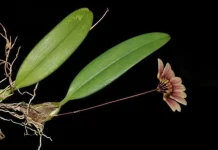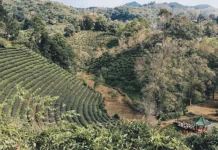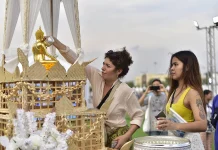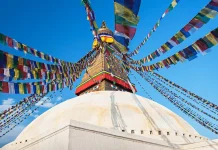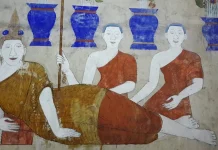After the monsoon season and heavy rainfall, the vivid red blossoms of Ngon Kai Daeng flowers are a welcome sight, signalling that winter will soon arrive at Phu Luang Wildlife Sanctuary.
Known as the “Ngon Kai Daeng,” which translates to “red rooster’s comb” in Thai, by the locals and park rangers in Loei Province, Northeastern Thailand, this Aeschynanthus plant has earned its name for its vivid red blossoms reminiscent of a rooster’s comb.
The Ngon Kai Daeng (Aeschynanthus rhododendron Rid.) is an epiphytic plant that thrives in the moist and evergreen mountain forests, at elevations ranging from 1,000 to 1,900 meters.

As an epiphyte on tree trunks or branches, the Ngon Kai Daeng plant can be found either as a single plant or in clumps of stems. The stems are flexible and often dangle from tree branches. Sometimes, they can even be found on the forest floor if they have fallen or broken off but are still able to survive. The leaves are solitary with a shape that falls between oblong and lanceolate forms, featuring pointed tips and bases, as well as edges that are slightly smooth or slightly serrated. The leaf surfaces are thick and glossy and have a dark green color.
The inflorescence blooms at the end of the branch as a single flower but packs together in clusters at the tip of the shoot. The Ngon Kai Daeng flower is perfect, having both male and female parts. Its petals form a long tube, curved like a hook, with a small base and divided lobes at the tip. The petals are bright red and trumpet-shaped, with deeply wavy tips. The sepals are fused together at the base, and the lower petals do not distinctly fold or bend backward.


After the monsoon season and heavy rainfall, the Ngon Kai Daeng flower is a welcome sight that winter will soon be here. The flowering period occurs from September to November. For those eager to observe and research the “Red Rooster’s Comb of Phu Luang” in its native environment, an exciting adventure awaits as they embark on a trek through the lush evergreen mountain forests, traversing picturesque nature trails.

Nan – Soothing tired eyes with a hundred shades of green
Located between downtown Nan and the Thai–Lao border, Pua is a bucolic green valley dotted with local villages, small Buddhist temples, and majestic mountain ranges. This small town in a tranquil valley attracts visitors looking for a permaculture retreat, a family-run café, and a farm stay.
Nestled in Loei province, the Phu Luang Wildlife Sanctuary was formed due to an uplift of the earth’s crust and a slide of soft soil down to lower land. The sanctuary is covered with pine forests and evergreen mountain forests, making it home to abundant flora and fauna. The park offers a six-kilometer nature trail, attracting campers and trekkers who come to observe wildflowers.
The Phu Luang Wildlife Sanctuary is open for camping and visiting from November to April. For more information, please call 064-024-0743 or visit its Facebook page at (https://web.facebook.com/phuluangws2517/).
Planning Your Trip
“Phu Luang Wildlife Sanctuary is located in Tha Sala, Phu Ruea District, Loei Province. Thai AirAsia operates flights from Bangkok to Loei. The wildlife sanctuary is approximately a one-hour drive (about 47 kilometers) south of Loei town centre.”


